Investigation and Optimization of Mxene Functionalized Mesoporous Titania Films as Efficient Photoelectrodes
Abstract
:Highlights
- ➢
- A novel Mxene functionalized Mesoporous TiO2 photoelectrode with a strong interconnectivity between Mxene sheets and 3D mesoporous structure is developed.
- ➢
- Improved optical and electrical properties of conductive anatase phase 3D TiO2.
- ➢
- Development of crack free films with Mxene-modified TiCl4 treatment.
- ➢
- Mxene functionalized mesoporous TiO2 is envisaged as a valuable platform for photoinduced energy conversion and storage applications.
1. Introduction
2. Materials and Methods
2.1. Synthesis of Mxene (Ti3CTx) Powder
2.2. Fabrication of TiO2: Mxene Films
2.3. Materials Characterization
3. Results and Discussion
3.1. (A) Mxene Powder Characterization
3.1.1. Structural Analysis
3.1.2. Optical Features
3.1.3. Morphological and Compositional Analysis
3.2. (B) Film Characterization
3.2.1. UV-Vis Absorbance Spectroscopy
3.2.2. Structural Analysis of the Mxene Functionalized Mesoporous Titania Layer
3.2.3. Morphological Analysis
3.2.4. Photo-Current Measurements
4. Conclusions
Supplementary Materials
Author Contributions
Funding
Institutional Review Board Statement
Informed Consent Statement
Data Availability Statement
Acknowledgments
Conflicts of Interest
References
- Wang, Y.; Suzuki, H.; Xie, J.; Tomita, O.; Martin, D.J.; Hgashi, M.; Kong, D.; Abe, R.; Tang, J. Mimicking Natural Photosynthesis: Solar to Renewable H2 Fuel Synthesis by Z-Scheme Water Splitting Systems. Chem. Rev. 2018, 118, 5201–5241. [Google Scholar] [CrossRef] [Green Version]
- Zhang, S.; Chen, C.; Zhou, Y.; Qian, Y.; Ye, J.; Xiong, S.; Zhao, Y.; Zhang, X. TiO2-photoanode-assisted direct-solar-energy harvesting and storage in a solar-powered redox cell using halides as active materials. ACS Appl. Mater. Interfaces 2018, 10, 23048–23054. [Google Scholar] [CrossRef]
- Green, M.A.; Ho-Baillie, A.; Snaith, H. The emergence of perovskite solar cells. Nat. Photon. 2014, 8, 506–514. [Google Scholar] [CrossRef]
- Thorne, J.E.; Li, S.; Du, C.; Qin, G.; Wang, D. Energetics at the Surface of Photoelectrodes and Its Influence on the Photoelectrochemical Properties. J. Phys. Chem. Lett. 2015, 6, 4083–4088. [Google Scholar] [CrossRef]
- Ke, J.; He, F.; Wu, H.; Lyu, S.; Liu, J.; Yang, B.; Li, Z.; Zhang, Q.; Chen, J.; Lei, L.; et al. Nanocarbon-Enhanced 2D Photoelectrodes: A New Paradigm in Photoelectrochemical Water Splitting. Nano-Micro Lett. 2020, 13, 1–29. [Google Scholar] [CrossRef] [PubMed]
- Acar, C.; Dincer, I. A review and evaluation of photoelectrode coating materials and methods for photoelectrochemical hydrogen production. Int. J. Hydrogen Energy 2015, 41, 7950–7959. [Google Scholar] [CrossRef]
- He, Y.; Hamann, T.; Wang, D. Thin film photoelectrodes for solar water splitting. Chem. Soc. Rev. 2019, 48, 2182–2215. [Google Scholar] [CrossRef] [PubMed]
- Hu, S.; Lewis, N.S.; Ager, J.W.; Yang, J.; McKone, J.R.; Strandwitz, N.C. Thin-Film Materials for the Protection of Semiconducting Photoelectrodes in Solar-Fuel Generators. J. Phys. Chem. C 2015, 119, 24201–24228. [Google Scholar] [CrossRef]
- Moss, B.; Babacan, O.; Kafizas, A.; Hankin, A. A Review of Inorganic Photoelectrode Developments and Reactor Scale-Up Challenges for Solar Hydrogen Production. Adv. Energy Mater. 2021, 11, 2003286. [Google Scholar] [CrossRef]
- Yang, J.W.; Ahn, S.H.; Jang, H.W. Crucial role of heterostructures in highly advanced water splitting photoelectrodes. Curr. Opin. Green Sustain. Chem. 2021, 29, 100454. [Google Scholar] [CrossRef]
- McGinn, P.J. Thin-Film Processing Routes for Combinatorial Materials Investigations—A Review. ACS Comb. Sci. 2019, 21, 501–515. [Google Scholar] [CrossRef] [PubMed]
- Swartwout, R.; Hoerantner, M.T.; Bulović, V. Scalable Deposition Methods for Large-area Production of Perovskite Thin Films. Energy Environ. Mater. 2019, 2, 119–145. [Google Scholar] [CrossRef] [Green Version]
- Mandoj, F.; Nardis, S.; Di Natale, C.; Paolesse, R. Porphyrinoid Thin Films for Chemical Sensing. Encycl. Interfacial Chem. 2018, 422–443. [Google Scholar] [CrossRef]
- Wu, D.; Zhao, C.; Xu, Y.; Zhang, X.; Yang, L.; Zhang, Y.; Gao, Z.; Song, Y.-Y. Modulating Solar Energy Harvesting on TiO2 Nanochannel Membranes by Plasmonic Nanoparticle Assembly for Desalination of Contaminated Seawater. ACS Appl. Nano Mater. 2020, 3, 10895–10904. [Google Scholar] [CrossRef]
- Li, W.; Liu, J.; Zhao, D. Mesoporous materials for energy conversion and storage devices. Nat. Rev. Mater. 2016, 1, 16023. [Google Scholar] [CrossRef]
- Guldin, S.; Hüttner, S.; Tiwana, P.; Orilall, M.C.; Ülgüt, B.; Stefik, M.; Docampo, P.; Kolle, M.; Divitini, G.; Ducati, C. Improved conductivity in dye-sensitised solar cells through block-copolymer confined TiO 2 crystallisation. Energy Environ. Sci. 2011, 4, 225–233. [Google Scholar] [CrossRef] [Green Version]
- Chen, D.; Huang, F.; Cheng, Y.-B.; Caruso, R.A. Mesoporous Anatase TiO2Beads with High Surface Areas and Controllable Pore Sizes: A Superior Candidate for High-Performance Dye-Sensitized Solar Cells. Adv. Mater. 2009, 21, 2206–2210. [Google Scholar] [CrossRef]
- Burschka, J.; Pellet, N.; Moon, S.-J.; Humphry-Baker, R.; Gao, P.; Nazeeruddin, M.K.; Grätzel, M. Sequential deposition as a route to high-performance perovskite-sensitized solar cells. Nature 2013, 499, 316–319. [Google Scholar] [CrossRef]
- Leijtens, T.; Lauber, B.; Eperon, G.E.; Stranks, S.D.; Snaith, H.J. The Importance of Perovskite Pore Filling in Organometal Mixed Halide Sensitized TiO2-Based Solar Cells. J. Phys. Chem. Lett. 2014, 5, 1096–1102. [Google Scholar] [CrossRef]
- Unger, E.L.; Fretz, S.J.; Lim, B.; Margulis, G.Y.; McGehee, M.D.; Stack, T.D.P. Sequential “click” functionalization of mesoporous titania for energy-relay dye enhanced dye-sensitized solar cells. Phys. Chem. Chem. Phys. 2015, 17, 6565–6571. [Google Scholar] [CrossRef]
- De Marco, L.; Manca, M.; Buonsanti, R.; Giannuzzi, R.; Malara, F.; Pareo, P.; Martiradonna, L.; Giancaspro, N.M.; Cozzoli, P.D.; Gigli, G. High-quality photoelectrodes based on shape-tailored TiO2 nanocrystals for dye-sensitized solar cells. J. Mater. Chem. 2011, 21, 13371–13379. [Google Scholar] [CrossRef]
- Heo, J.H.; You, M.S.; Chang, M.H.; Yin, W.; Ahn, T.K.; Lee, S.-J.; Sung, S.-J.; Kim, D.H.; Im, S.H. Hysteresis-less mesoscopic CH3NH3PbI3 perovskite hybrid solar cells by introduction of Li-treated TiO2 electrode. Nano Energy 2015, 15, 530–539. [Google Scholar] [CrossRef]
- Zhang, X.; Thavasi, V.; Mhaisalkar, S.G.; Ramakrishna, S. Novel hollow mesoporous 1D TiO2 nanofibers as photovoltaic and photocatalytic materials. Nanoscale 2012, 4, 1707–1716. [Google Scholar] [CrossRef] [PubMed]
- Reghunath, S.; Pinheiro, D.; Kr, S.D. A review of hierarchical nanostructures of TiO2: Advances and applications. Appl. Surf. Sci. Adv. 2021, 3, 100063. [Google Scholar] [CrossRef]
- Liang, Y.T.; Vijayan, B.K.; Gray, K.A.; Hersam, M.C. Minimizing Graphene Defects Enhances Titania Nanocomposite-Based Photocatalytic Reduction of CO2 for Improved Solar Fuel Production. Nano Lett. 2011, 11, 2865–2870. [Google Scholar] [CrossRef]
- Li, X.; Bai, Y.; Shi, X.; Su, N.; Nie, G.; Zhang, R.; Nie, H.; Ye, L. Applications of MXene (Ti3C2Tx) in photocatalysis: A review. Mater. Adv. 2021, 2, 1570–1594. [Google Scholar] [CrossRef]
- Naguib, M.; Mashtalir, O.; Carle, J.; Presser, V.; Lu, J.; Hultman, L.; Gogotsi, Y.; Barsoum, M.W. Two-Dimensional Transition Metal Carbides. ACS Nano 2012, 6, 1322–1331. [Google Scholar] [CrossRef]
- Halim, J.; Kota, S.; Lukatskaya, M.R.; Naguib, M.; Zhao, M.-Q.; Moon, E.J.; Pitock, J.; Nanda, J.; May, S.J.; Gogotsi, Y.; et al. Synthesis and Characterization of 2D Molybdenum Carbide (MXene). Adv. Funct. Mater. 2016, 26, 3118–3127. [Google Scholar] [CrossRef]
- Munir, S.; Rasheed, A.; Rasheed, T.; Ayman, I.; Ajmal, S.; Rehman, A.; Shakir, I.; Agboola, P.O.; Warsi, M.F. Exploring the Influence of Critical Parameters for the Effective Synthesis of High-Quality 2D MXene. ACS Omega 2020, 5, 26845–26854. [Google Scholar] [CrossRef]
- Yang, C.; Huang, H.; He, H.; Yang, L.; Jiang, Q.; Li, W. Recent advances in MXene-based nanoarchitectures as electrode materials for future energy generation and conversion applications. Co-Ord. Chem. Rev. 2021, 435, 213806. [Google Scholar] [CrossRef]
- Peng, J.; Chen, X.; Ong, W.-J.; Zhao, X.; Li, N. Surface and Heterointerface Engineering of 2D MXenes and Their Nanocomposites: Insights into Electro- and Photocatalysis. Chemistry 2018, 5, 18–50. [Google Scholar] [CrossRef] [Green Version]
- Jolly, S.; Paranthaman, M.; Naguib, M. Synthesis of Ti3C2Tz MXene from low-cost and environmentally friendly precursors. Mater. Today Adv. 2021, 10, 100139. [Google Scholar] [CrossRef]
- Ran, J.; Gao, G.; Li, F.-T.; Ma, T.-Y.; Du, A.; Qiao, S.-Z. Ti3C2 MXene co-catalyst on metal sulfide photo-absorbers for enhanced visible-light photocatalytic hydrogen production. Nat. Commun. 2017, 8, 13907. [Google Scholar] [CrossRef] [PubMed] [Green Version]
- Zhang, S.; Liu, Y.; Feng, M.; Zhang, B.; Yu, T.; Xu, S.; Sun, G.; Wang, D. Leaf-like MXene nanosheets intercalated TiO2 nanorod array photoelectrode with enhanced photoelectrochemical performance. J. Power Sources 2020, 484, 229236. [Google Scholar] [CrossRef]
- He, L.; Tan, C.; Sheng, C.; Chen, Y.; Yu, F.; Chen, Y. A β-FeOOH/MXene sandwich for high-performance anodes in lithium-ion batteries. Dalton Trans. 2020, 49, 9268–9273. [Google Scholar] [CrossRef] [PubMed]
- Wang, Y.; Li, Y.; Qiu, Z.; Wu, X.; Zhou, P.; Zhou, T.; Zhao, J.; Miao, Z.; Zhou, J.; Zhuo, S. Fe3O4@ Ti3C2 MXene hybrids with ultrahigh volumetric capacity as an anode material for lithium-ion batteries. J. Mater. Chem. A 2018, 6, 11189–11197. [Google Scholar] [CrossRef]
- Zou, G.; Zhang, Z.; Guo, J.; Liu, B.; Zhang, Q.; Fernandez, C.; Peng, Q. Synthesis of MXene/Ag composites for extraordinary long cycle lifetime lithium storage at high rates. ACS Appl. Mater. Interfaces 2016, 8, 22280–22286. [Google Scholar] [CrossRef]
- Yang, C.; Liu, Y.; Sun, Z.; Zhang, Y.; Hou, L.; Zhang, Q.; Yuan, C. In-situ construction of hierarchical accordion-like TiO2/Ti3C2 nanohybrid as anode material for lithium and sodium ion batteries. Electrochim. Acta 2018, 271, 165–172. [Google Scholar] [CrossRef]
- Qiu, S.-Y.; Wang, C.; Jiang, Z.-X.; Zhang, L.-S.; Gu, L.-L.; Wang, K.-X.; Gao, J.; Zhu, X.-Z.; Wu, G. Rational design of MXene@ TiO2 nanoarray enabling dual lithium polysulfide chemisorption towards high-performance lithium–sulfur batteries. Nanoscale 2020, 12, 16678–16684. [Google Scholar] [CrossRef]
- Yilbas, B.S.; Al-Sharafi, A.; Ali, H. Chapter 3—Surfaces for Self-Cleaning. In Self-Cleaning of Surfaces and Water Droplet Mobility; Yilbas, B.S., Al-Sharafi, A., Ali, H., Eds.; Elsevier: Amsterdam, The Netherlands, 2019; pp. 45–98. [Google Scholar]
- Naguib, M.; Kurtoglu, M.; Presser, V.; Lu, J.; Niu, J.; Heon, M.; Hultman, L.; Gogotsi, Y.; Barsoum, M.W. Two-dimensional nanocrystals produced by exfoliation of Ti3AlC2. Adv. Mater. 2011, 23, 4248–4253. [Google Scholar] [CrossRef] [Green Version]
- Yan, P.; Zhang, R.; Jia, J.; Wu, C.; Zhou, A.; Xu, J.; Zhang, X. Enhanced supercapacitive performance of delaminated two-dimensional titanium carbide/carbon nanotube composites in alkaline electrolyte. J. Power Sources 2015, 284, 8–43. [Google Scholar] [CrossRef]
- Zhao, C.; Wang, Q.; Zhang, H.; Passerini, S.; Qian, X. Two-dimensional titanium carbide/RGO composite for high-performance supercapacitors. ACS Appl. Mater. Interfaces 2016, 8, 15661–15667. [Google Scholar] [CrossRef]
- Ghidiu, M.; Halim, J.; Kota, S.; Bish, D.; Gogotsi, Y.; Barsoum, M.W. Ion-exchange and cation solvation reactions in Ti3C2 MXene. Chem. Mater. 2016, 28, 3507–3514. [Google Scholar] [CrossRef] [Green Version]
- Xia, Q.X.; Shinde, N.M.; Yun, J.M.; Zhang, T.; Mane, R.S.; Mathur, S.; Kim, K.H. Bismuth oxychloride/MXene symmetric supercapacitor with high volumetric energy density. Electrochim. Acta 2018, 271, 351–360. [Google Scholar] [CrossRef]
- Peng, C.; Wei, P.; Chen, X.; Zhang, Y.; Zhu, F.; Cao, Y.; Wang, H.; Yu, H.; Peng, F. A hydrothermal etching route to synthesis of 2D MXene (Ti3C2, Nb2C): Enhanced exfoliation and improved adsorption performance. Ceram. Int. 2018, 44, 18886–18893. [Google Scholar] [CrossRef]
- Wang, H.; Wu, Y.; Zhang, J.; Li, G.; Huang, H.; Zhang, X.; Jiang, Q. Enhancement of the electrical properties of MXene Ti3C2 nanosheets by post-treatments of alkalization and calcination. Mater. Lett. 2015, 160, 537–540. [Google Scholar] [CrossRef]
- Li, X.; Fan, G.; Zeng, C. Synthesis of ruthenium nanoparticles deposited on graphene-like transition metal carbide as an effective catalyst for the hydrolysis of sodium borohydride. Int. J. Hydrogen Energy 2014, 39, 14927–14934. [Google Scholar] [CrossRef]
- Huang, Y.; Yang, H.; Zhang, Y.; Zhang, Y.; Wu, Y.; Tian, M.; Chen, P.; Trout, R.; Ma, Y.; Wu, T.-H.; et al. A safe and fast-charging lithium-ion battery anode using MXene supported Li3VO4. J. Mater. Chem. A 2019, 7, 11250–11256. [Google Scholar] [CrossRef]
- Lim, G.P.; Soon, C.F.; Morsin, M.; Ahmad, M.K.; Nayan, N.; Tee, K.S. Synthesis, characterization and antifungal property of Ti3C2Tx MXene nanosheets. Ceram. Int. 2020, 46, 20306–20312. [Google Scholar] [CrossRef]
- Cockreham, C.B.; Zhang, X.; Li, H.; Hammond-Pereira, E.; Sun, J.; Saunders, S.R.; Wang, Y.; Xu, H.; Wu, D. Inhibition of AlF3-3H2O Impurity Formation in Ti3C2Tx MXene Synthesis under a Unique CoFx/HCl Etching Environment. ACS Appl. Energy Mater. 2019, 2, 8145–8152. [Google Scholar] [CrossRef]
- Li, Y.; Zhou, X.; Wang, J.; Deng, Q.; Li, M.; Du, S.; Han, Y.-H.; Lee, J.; Huang, Q. Facile preparation of in situ coated Ti 3 C 2 T x/Ni 0.5 Zn 0.5 Fe2O4 composites and their electromagnetic performance. RSC Adv. 2017, 7, 24698–24708. [Google Scholar] [CrossRef] [Green Version]
- Cao, Y.; Deng, Q.; Liu, Z.; Shen, D.; Wang, T.; Huang, Q.; Du, S.; Jiang, N.; Lin, C.-T.; Yu, J. Enhanced thermal properties of poly (vinylidene fluoride) composites with ultrathin nanosheets of MXene. RSC Adv. 2017, 7, 20494–20501. [Google Scholar] [CrossRef] [Green Version]
- Spanier, J.E.; Gupta, S.; Amer, M.; Barsoum, M.W. Vibrational behavior of the M n + 1 A X n phases from first-order Raman scattering (M = Ti, V, Cr, A = Si, X = C, N). Phys. Rev. B 2005, 71, 012103. [Google Scholar] [CrossRef] [Green Version]
- Syamsai, R.; Kollu, P.; Jeong, S.K.; Grace, A.N. Synthesis and properties of 2D-titanium carbide MXene sheets towards electrochemical energy storage applications. Ceram. Int. 2017, 43, 13119–13126. [Google Scholar] [CrossRef]
- Sarycheva, A.; Gogotsi, Y. Raman Spectroscopy Analysis of the Structure and Surface Chemistry of Ti3C2Tx MXene. Chem. Mater. 2020, 32, 3480–3488. [Google Scholar] [CrossRef]
- Cheng, L.; Chen, Q.; Li, J.; Liu, H. Boosting the photocatalytic activity of CdLa2S4 for hydrogen production using Ti3C2 MXene as a co-catalyst. Appl. Catal. B Environ. 2020, 267, 118379. [Google Scholar] [CrossRef]
- Melchior, S.A.; Raju, K.; Ike, I.S.; Erasmus, R.M.; Kabongo, G.; Sigalas, I.; Iyuke, S.E.; Ozoemena, K.I. High-voltage symmetric supercapacitor based on 2D titanium carbide (MXene, Ti2CTx)/carbon nanosphere composites in a neutral aqueous electrolyte. J. Electrochem. Soc. 2018, 165, A501. [Google Scholar] [CrossRef] [Green Version]
- Lai, S.; Jeon, J.; Jang, S.K.; Xu, J.; Choi, Y.J.; Park, J.-H.; Hwang, E.; Lee, S. Surface group modification and carrier transport properties of layered transition metal carbides (Ti2CTx, T:–OH,–F and–O). Nanoscale 2015, 7, 19390–19396. [Google Scholar] [CrossRef]
- Liu, F.; Zhou, A.; Chen, J.; Zhang, D.; Cao, J.; Wang, L.; Hu, Q. Preparation and methane adsorption of two-dimensional carbide Ti 2 C. Adsorption 2016, 22, 915–922. [Google Scholar] [CrossRef]
- Ma, J.Y.; Sun, M.; Zhu, Y.A.; Zhou, H.; Wu, K.; Xiao, J.; Wu, M. Highly Effective 2D Layer Structured Titanium Carbide Electrode for Dye-Sensitized and Perovskite Solar Cells. ChemElectroChem 2020, 7, 1149–1154. [Google Scholar] [CrossRef]
- Han, M.; Yin, X.; Wu, H.; Hou, Z.; Song, C.; Li, X.; Zhang, L.; Cheng, L. Ti3C2 MXenes with Modified Surface for High-Performance Electromagnetic Absorption and Shielding in the X-Band. ACS Appl. Mater. Interfaces 2016, 8, 21011–21019. [Google Scholar] [CrossRef]
- Ferrari, A.C.; Robertson, J. Interpretation of Raman spectra of disordered and amorphous carbon. Phys. Rev. B 2000, 61, 14095. [Google Scholar] [CrossRef] [Green Version]
- Presser, V.; Naguib, M.; Chaput, L.; Togo, A.; Hug, G.; Barsoum, M.W. First-order Raman scattering of the MAX phases: Ti2AlN, Ti2AlC0. 5N0. 5, Ti2AlC,(Ti0. 5V0. 5) 2AlC, V2AlC, Ti3AlC2, and Ti3GeC2. J. Raman Spectrosc. 2012, 43, 168–172. [Google Scholar] [CrossRef]
- Wang, B.; Zhou, A.; Liu, F.; Cao, J.; Wang, L.; Hu, Q. Carbon dioxide adsorption of two-dimensional carbide MXenes. J. Adv. Ceram. 2018, 7, 237–245. [Google Scholar] [CrossRef] [Green Version]
- Hu, T.; Wang, J.; Zhang, H.; Li, Z.; Hu, M.; Wang, X. Vibrational properties of Ti3C2 and Ti3C2T2 (T= O, F, OH) monosheets by first-principles calculations: A comparative study. Phys. Chem. Chem. Phys. 2015, 17, 9997–10003. [Google Scholar] [CrossRef] [PubMed]
- Shuck, C.E.; Sarycheva, A.; Anayee, M.; Levitt, A.; Zhu, Y.; Uzun, S.; Balitskiy, V.; Zahorodna, V.; Gogotsi, O.; Gogotsi, Y. Scalable synthesis of Ti3C2Tx mxene. Adv. Eng. Mater. 2020, 22, 1901241. [Google Scholar] [CrossRef]
- Kaipoldayev, O.; Mukhametkarimov, Y.; Nemkaeva, R.; Baigarinova, G.; Aitzhanov, M.; Muradov, A.; Guseinov, N. Studying of 2D titanium carbide structure by Raman spectroscopy after heat treatment in argon and hydrogen atmospheres. Eurasian Chem. Technol. J. 2017, 19, 197–200. [Google Scholar] [CrossRef] [Green Version]
- Li, R.; Zhang, L.; Shi, L.; Wang, P.; Xene, M. Ti3C2: An effective 2D light-to-heat conversion material. ACS Nano 2017, 11, 3752–3759. [Google Scholar] [CrossRef] [PubMed] [Green Version]
- Han, F.; Luo, S.; Xie, L.; Zhu, J.; Wei, W.; Chen, X.; Liu, F.; Chen, W.; Zhao, J.; Dong, L. Boosting the yield of MXene 2D sheets via a facile hydrothermal-assisted intercalation. ACS Appl. Mater. Interfaces 2019, 11, 8443–8452. [Google Scholar] [CrossRef]
- Cheng, L.; Tang, Y.; Xie, M.; Sun, Y.; Liu, H. 2D ultrathin NiMOF decorated by Ti3C2 MXene for highly improved photocatalytic performance. J. Alloys Compd. 2021, 864, 158913. [Google Scholar] [CrossRef]
- Shao, B.; Wang, J.; Liu, Z.; Zeng, G.; Tang, L.; Liang, Q.; He, Q.; Wu, T.; Liu, Y.; Yuan, X. Ti3C2Tx MXene decorated black phosphorus nanosheets with improved visible-light photocatalytic activity: Experimental and theoretical studies. J. Mater. Chem. A 2020, 8, 5171–5185. [Google Scholar] [CrossRef]
- Xuan, J.; Wang, Z.; Chen, Y.; Liang, D.; Cheng, L.; Yang, X.; Liu, Z.; Ma, R.; Sasaki, T.; Geng, T. Organic-base-driven intercalation and delamination for the production of functionalized titanium carbide nanosheets with superior photothermal therapeutic performance. Angew. Chem. 2016, 128, 14789–14794. [Google Scholar] [CrossRef]
- Xie, Y.; Rahman, M.M.; Kareem, S.; Dong, H.; Qiao, F.; Xiong, W.; Liu, X.; Li, N.; Zhao, X. Facile synthesis of CuS/MXene nanocomposites for efficient photocatalytic hydrogen generation. CrystEngComm 2020, 22, 2060–2066. [Google Scholar] [CrossRef]
- Tang, R.; Zhou, S.; Li, C.; Chen, R.; Zhang, L.; Zhang, Z.; Yin, L. Janus-Structured Co-Ti3C2 MXene Quantum Dots as a Schottky Catalyst for High-Performance Photoelectrochemical Water Oxidation. Adv. Funct. Mater. 2020, 30, 2000637. [Google Scholar] [CrossRef]
- Luo, Q.; Chai, B.; Xu, M.; Cai, Q. Preparation and photocatalytic activity of TiO2-loaded Ti3C2 with small interlayer spacing. Appl. Phys. A 2018, 124, 495. [Google Scholar] [CrossRef]
- Chaudhuri, K.; Wang, Z.; Alhabeb, M.; Maleski, K.; Gogotsi, Y.; Shalaev, V.; Boltasseva, A. Optical Properties of MXenes. In 2D Metal Carbides and Nitrides; Springer: New York, NY, USA, 2019; pp. 327–346. [Google Scholar]
- Sarycheva, A.; Makaryan, T.; Maleski, K.; Satheeshkumar, E.; Melikyan, A.; Minassian, H.; Yoshimura, M.; Gogotsi, Y. Two-dimensional titanium carbide (MXene) as surface-enhanced Raman scattering substrate. J. Phys. Chem. C 2017, 121, 19983–19988. [Google Scholar] [CrossRef]
- Zhang, H.; Li, M.; Cao, J.; Tang, Q.; Kang, P.; Zhu, C.; Ma, M. 2D a-Fe2O3 doped Ti3C2 MXene composite with enhanced visible light photocatalytic activity for degradation of Rhodamine B. Ceram. Int. 2018, 44, 9958–19962. [Google Scholar] [CrossRef]
- Liu, Q.; Tan, X.; Wang, S.; Ma, F.; Znad, H.; Shen, Z.; Liu, L.; Liu, S. MXene as a non-metal charge mediator in 2D layered CdS@ Ti3C2@ TiO2 composites with superior Z-scheme visible light-driven photocatalytic activity. Environ. Sci. Nano 2019, 6, 3158–3169. [Google Scholar] [CrossRef]
- Yang, L.; Dall’Agnese, Y.; Hantanasirisakul, K.; Shuck, C.E.; Maleski, K.; Alhabeb, M.; Chen, G.; Gao, Y.; Sanehira, Y.; Jena, A.K. SnO2–Ti3C2 MXene electron transport layers for perovskite solar cells. J. Mater. Chem. A 2019, 7, 5635–5642. [Google Scholar] [CrossRef]
- Yang, L.; Dall’Agnese, C.; Dall’Agnese, Y.; Chen, G.; Gao, Y.; Sanehira, Y.; Jena, A.K.; Wang, X.F.; Gogotsi, Y.; Miyasaka, T. Surface-Modified Metallic Ti3C2Tx MXene as Electron Transport Layer for Planar Heterojunction Perovskite Solar Cells. Adv. Funct. Mater. 2019, 29, 1905694. [Google Scholar] [CrossRef]
- Li, Z.; Wang, L.; Sun, D.; Zhang, Y.; Liu, B.; Hu, Q.; Zhou, A. Synthesis and thermal stability of two-dimensional carbide MXene Ti3C2. Mater. Sci. Eng. B 2015, 191, 33–40. [Google Scholar] [CrossRef]
- Feng, A.; Yu, Y.; Wang, Y.; Jiang, F.; Yu, Y.; Mi, L.; Song, L. Two-dimensional MXene Ti3C2 produced by exfoliation of Ti3AlC2. Mater. Des. 2017, 114, 161–166. [Google Scholar] [CrossRef]
- Shen, B.; Hu, Z.; Sun, K.; Lu, C.; Jiang, Y.; Zhang, J.; Chen, Y.; Zhu, Y. Conformal coverage of TiO2 compact layers for high-efficient planar heterojunction perovskite solar cells. Org. Electron. 2018, 59, 177–183. [Google Scholar] [CrossRef]
- Huh, D.; Oh, K.; Kim, M.; Choi, H.-J.; Kim, D.S.; Lee, H. Selectively patterned TiO2 nanorods as electron transport pathway for high performance perovskite solar cells. Nano Res. 2018, 12, 601–606. [Google Scholar] [CrossRef]
- Dundar, I.; Mere, A.; Mikli, V.; Krunks, M.; Acik, I.O. Thickness Effect on Photocatalytic Activity of TiO2 Thin Films Fabricated by Ultrasonic Spray Pyrolysis. Catalysts 2020, 10, 1058. [Google Scholar] [CrossRef]
- Kumar, S.; Aftab, A.; Ahmad, I. Compact Titania Films by Spray Pyrolysis for Application as ETL in Perovskite Solar Cells. J. Electron. Mater. 2020, 49, 7159–7167. [Google Scholar] [CrossRef]
- Zhang, C.; Luo, Y.; Chen, X.; Ou-Yang, W.; Chen, Y.; Sun, Z.; Huang, S. Influence of different TiO2 blocking films on the photovoltaic performance of perovskite solar cells. Appl. Surf. Sci. 2016, 388, 82–88. [Google Scholar] [CrossRef]
- Qin, J.; Zhang, Z.; Shi, W.; Liu, Y.; Gao, H.; Mao, Y. The optimum titanium precursor of fabricating TiO2 compact layer for perovskite solar cells. Nanoscale Res. Lett. 2017, 12, 1–9. [Google Scholar] [CrossRef] [PubMed] [Green Version]
- Makuła, P.; Pacia, M.; Macyk, W. How To Correctly Determine the Band Gap Energy of Modified Semiconductor Photocatalysts Based on UV–Vis Spectra. J. Phys. Chem. Lett. 2018, 9, 6814–6817. [Google Scholar] [CrossRef] [PubMed] [Green Version]
- Arshad, Z.; Khoja, A.H.; Shakir, S.; Afzal, A.; Mujtaba, M.; Soudagar, M.E.M.; Fayaz, H.; Farukh, S.; Saeed, M. Magnesium doped TiO2 as an efficient electron transport layer in perovskite solar cells. Case Stud. Therm. Eng. 2021, 53–55. [Google Scholar] [CrossRef]
- Yang, L.; Kan, D.; Dall’Agnese, C.; Dall’Agnese, Y.; Wang, B.; Jena, A.K.; Wei, Y.; Chen, G.; Wang, X.-F.; Gogotsi, Y. Performance improvement of MXene-based perovskite solar cells upon property transition from metallic to semiconductive by oxidation of Ti3C2Tx in air. J. Mater. Chem. A 2021, 9, 5016–5025. [Google Scholar] [CrossRef]
- Möllmann, A.; Gedamu, D.; Vivo, P.; Frohnhoven, R.; Stadler, D.; Fischer, T.; Ka, I.; Steinhorst, M.; Nechache, R.; Rosei, F. Highly compact TiO2 films by spray pyrolysis and application in perovskite solar cells. Adv. Eng. Mater. 2019, 21, 1801196. [Google Scholar] [CrossRef]
- Lv, Y.; Yuan, R.; Cai, B.; Bahrami, B.; Chowdhury, A.H.; Yang, C.; Wu, Y.; Qiao, Q.; Liu, S.; Zhang, W.H. High-Efficiency Perovskite Solar Cells Enabled by Anatase TiO2 Nanopyramid Arrays with an Oriented Electric Field. Angew. Chem. Int. Ed. 2020, 59, 11969–11976. [Google Scholar] [CrossRef]
- Zhao, X.; Zhao, J.; He, J.; Li, B.; Zhang, Y.; Hu, J.; Wang, H.; Zhang, D.; Liu, Q. Porous anatase TiO2 nanocrystal derived from the metal–organic framework as electron transport material for carbon-based perovskite solar cells. ACS Appl. Energy Mater. 2020, 3, 6180–6187. [Google Scholar] [CrossRef]
- Raval, D.; Jani, M.; Chaliyawala, H.; Joshi, A.; Mukhopadhyay, I.; Ray, A. Solar to chemical energy conversion using titania nanorod photoanodes augmented by size distribution of plasmonic Au-nanoparticle. Mater. Chem. Phys. 2019, 231, 322–334. [Google Scholar] [CrossRef]
- Tang, H.; Zhuang, S.; Bao, Z.; Lao, C.; Mei, Y. Two-Step Oxidation of Mxene in the Synthesis of Layer-Stacked Anatase Titania with Enhanced Lithium-Storage Performance. ChemElectroChem 2016, 3, 871–876. [Google Scholar] [CrossRef]
- Sreedhar, A.; Jung, H.; Kwon, J.H.; Yi, J.; Sohn, Y.; Gwag, J.S. Novel composite ZnO/TiO2 thin film photoanodes for enhanced visible-light-driven photoelectrochemical water splitting activity. J. Electroanal. Chem. 2017, 804, 92–98. [Google Scholar] [CrossRef]
- Dubey, R.; Singh, S. Investigation of structural and optical properties of pure and chromium doped TiO2 nanoparticles prepared by solvothermal method. Results Phys. 2017, 7, 1283–1288. [Google Scholar] [CrossRef]
- Jiang, Z.; Yang, D.; Wang, N.; Zhang, F.; Zhao, B.; Tan, S.; Zhang, J. Inverted polymer solar cells with TiO2 electron extraction layers prepared by magnetron sputtering. Sci. China Ser. B: Chem. 2013, 56, 1573–1577. [Google Scholar] [CrossRef]
- Naguib, M.; Mashtalir, O.; Lukatskaya, M.R.; Dyatkin, B.; Zhang, C.; Presser, V.; Gogotsi, Y.; Barsoum, M.W. One-step synthesis of nanocrystalline transition metal oxides on thin sheets of disordered graphitic carbon by oxidation of MXenes. Chem. Commun. 2014, 50, 7420–7423. [Google Scholar] [CrossRef] [Green Version]
- Li, H.; Robichaud, J.; Djaoued, Y. A simple way to fabricate pure anatase 2D TiO2 IO monolayer: Structure, color control and its application in electrochromism. RSC Adv. 2021, 11, 8065–8072. [Google Scholar] [CrossRef]
- Yang, Y.-Y.; Zhou, W.-T.; Song, W.-L.; Zhu, Q.Q.; Xiong, H.-J.; Zhang, Y.; Cheng, S.; Luo, P.-F.; Lu, Y.-W. Terminal Groups-Dependent Near-Field Enhancement Effect of Ti 3 C 2 T x Nanosheets. Nanoscale Res. Lett. 2021, 16, 1–7. [Google Scholar] [CrossRef] [PubMed]
- Gajjela, S.R.; Ananthanarayanan, K.; Yap, C.; Grätzel, M.; Balaya, P. Synthesis of mesoporous titanium dioxide by soft template based approach: Characterization and application in dye-sensitized solar cells. Energy Environ. Sci. 2010, 3, 838–845. [Google Scholar] [CrossRef]
- Mozaffari, N.; Mohammadi, M.R.; Garmaroudi, Z.A.; Gharavi, P.S.M. Comparative study on effect of titania morphology for light harvesting and scattering of DSSCs: Mesoporous nanoparticles, microspheres, and dandelion-like particles. Environ. Prog. Sustain. Energy 2016, 35, 1818–1826. [Google Scholar] [CrossRef]
- Park, J.T.; Prosser, J.H.; Ahn, S.H.; Kim, S.J.; Kim, J.H.; Lee, D. Enhancing the Performance of Solid-State Dye-Sensitized Solar Cells Using a Mesoporous Interfacial Titania Layer with a Bragg Stack. Adv. Funct. Mater. 2013, 23, 2193–2200. [Google Scholar] [CrossRef]

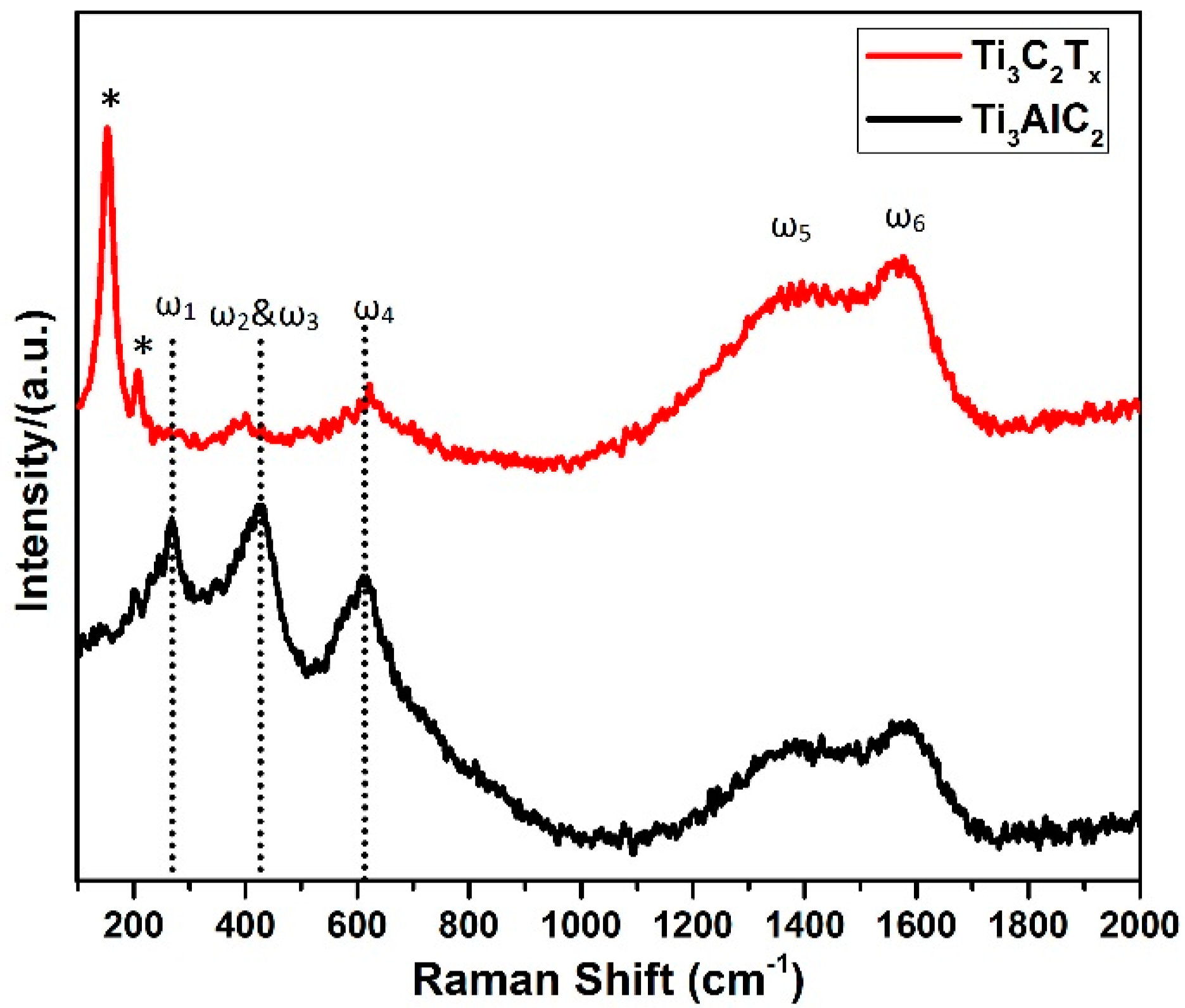


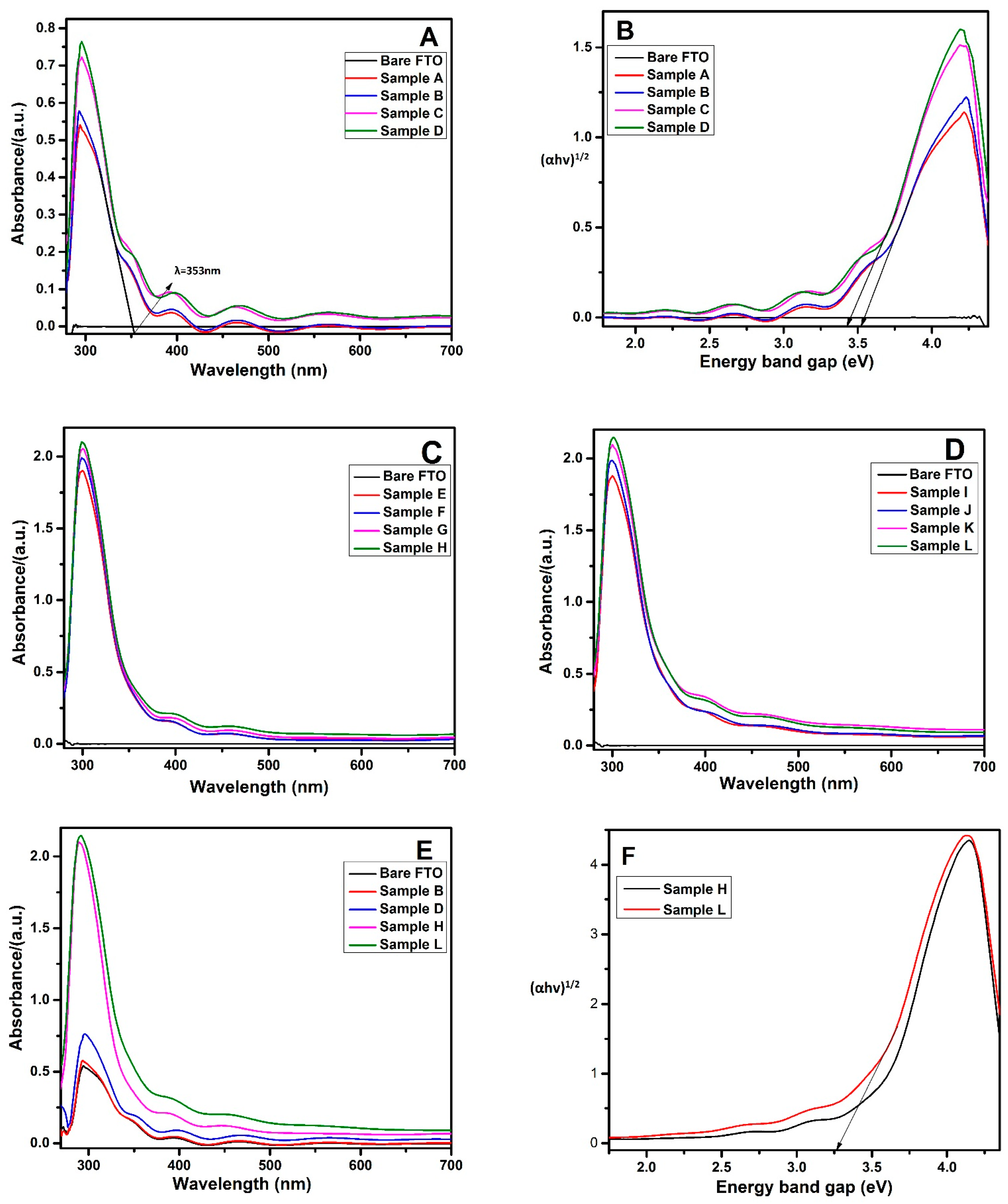
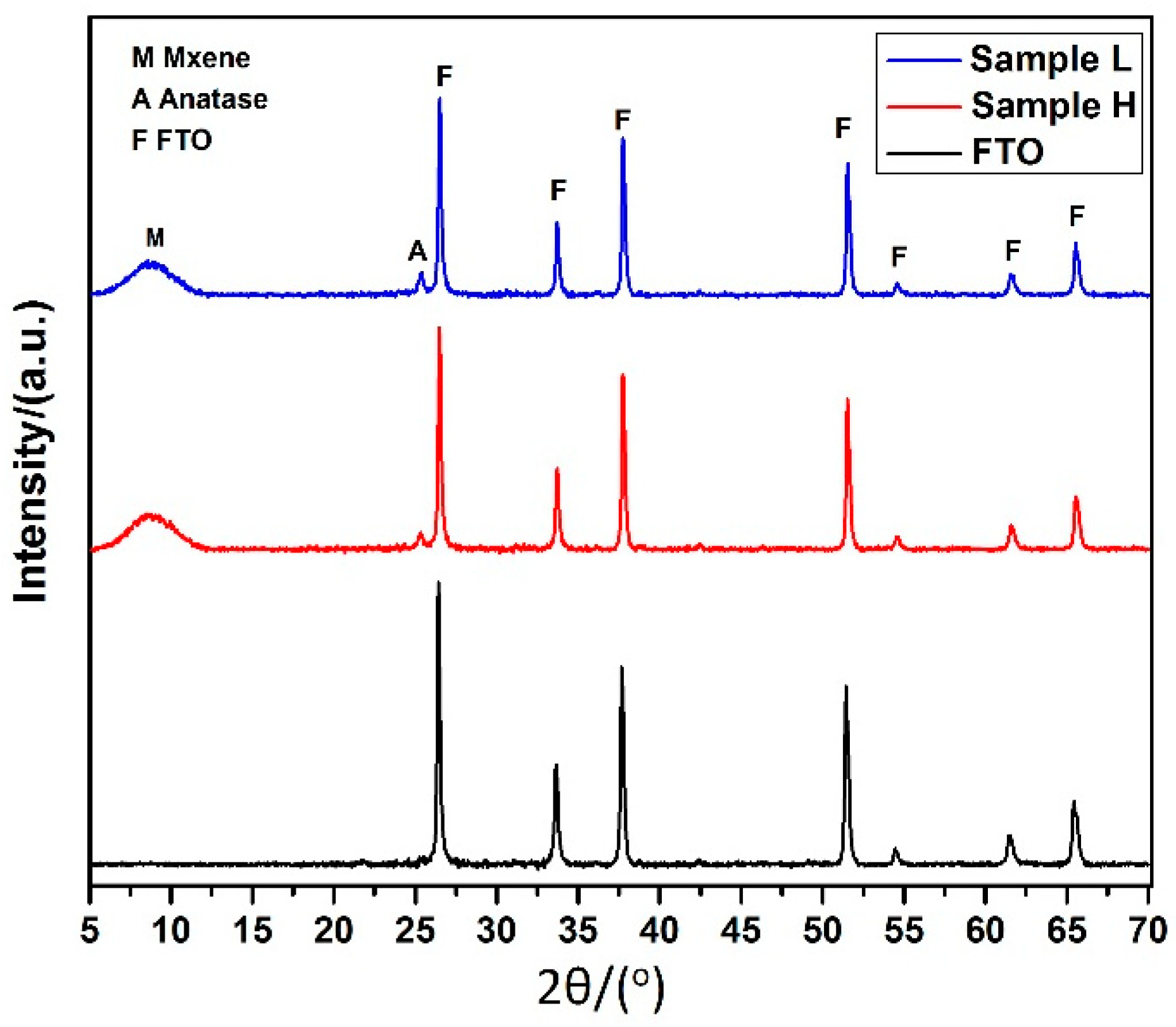
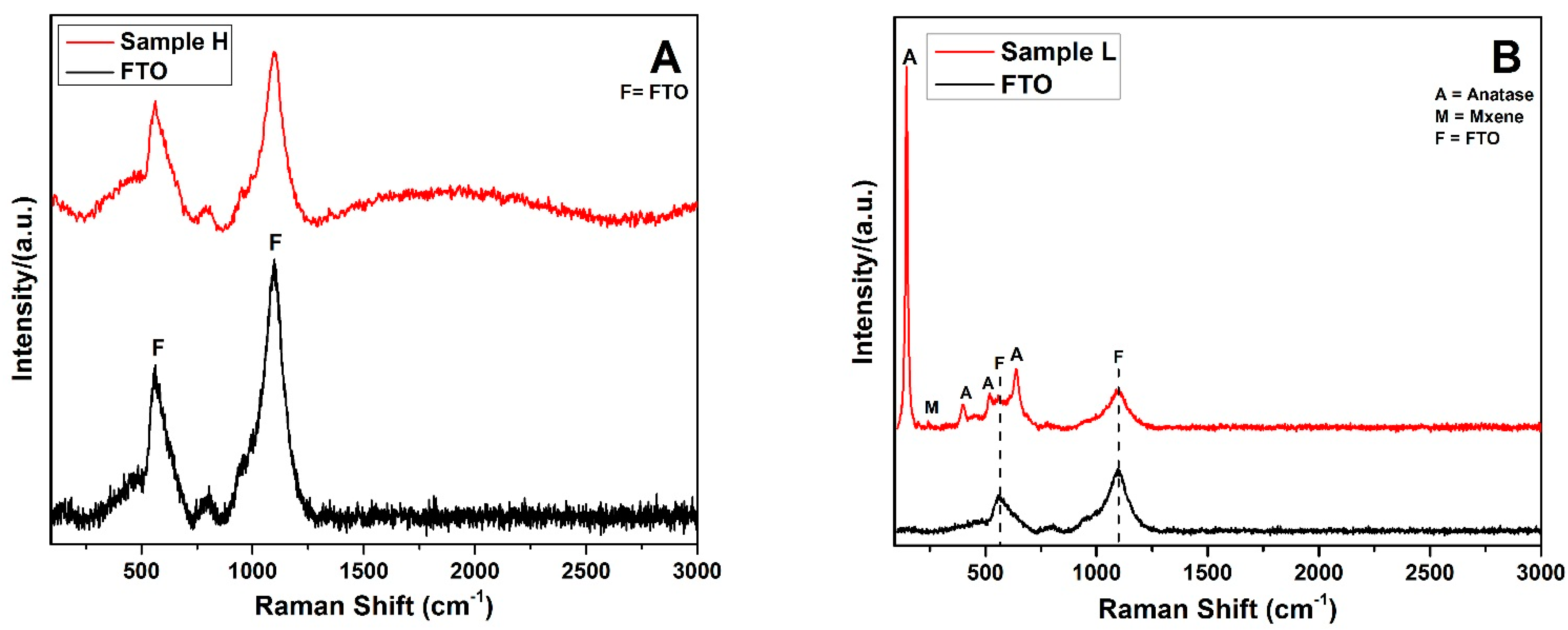
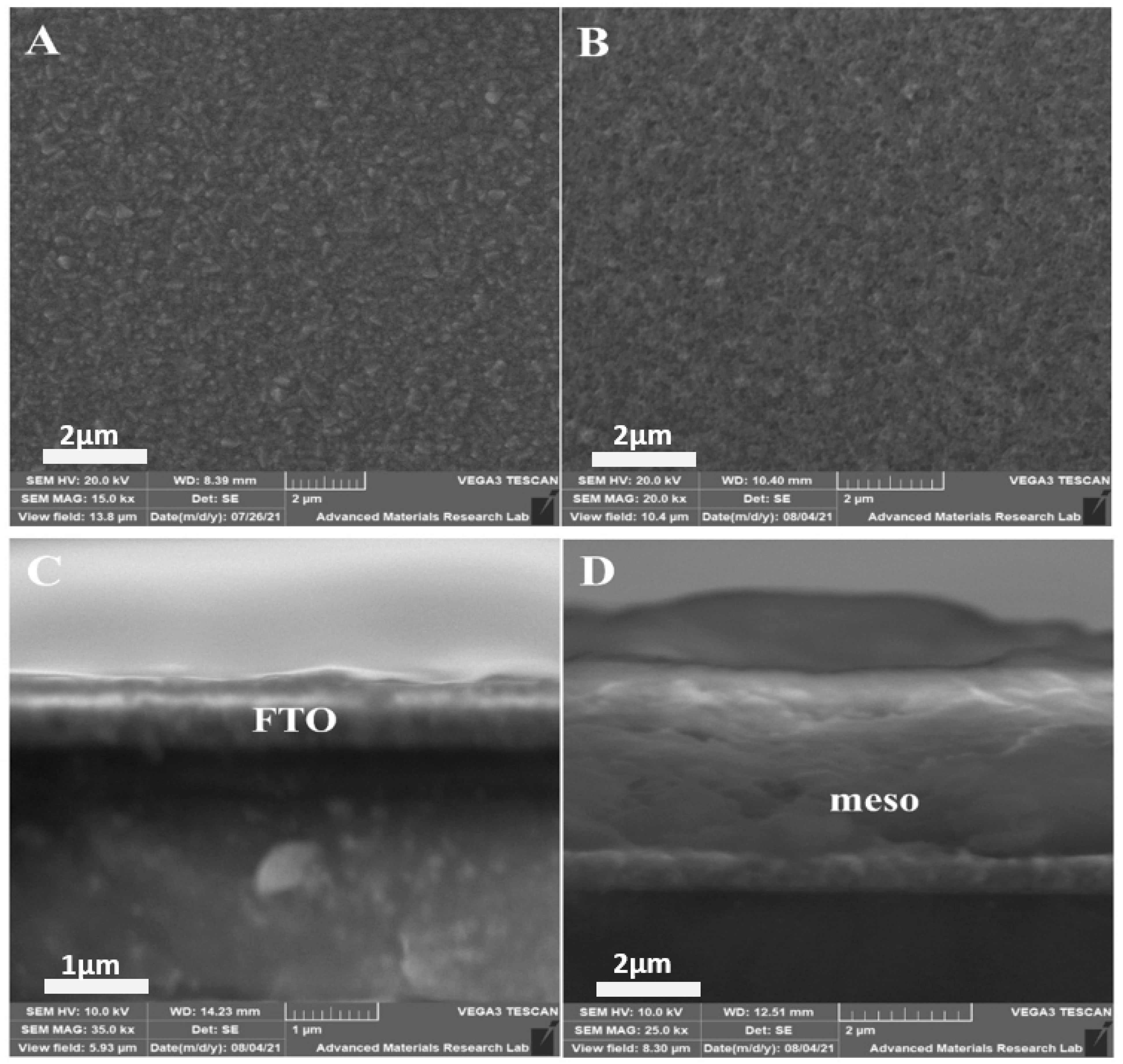
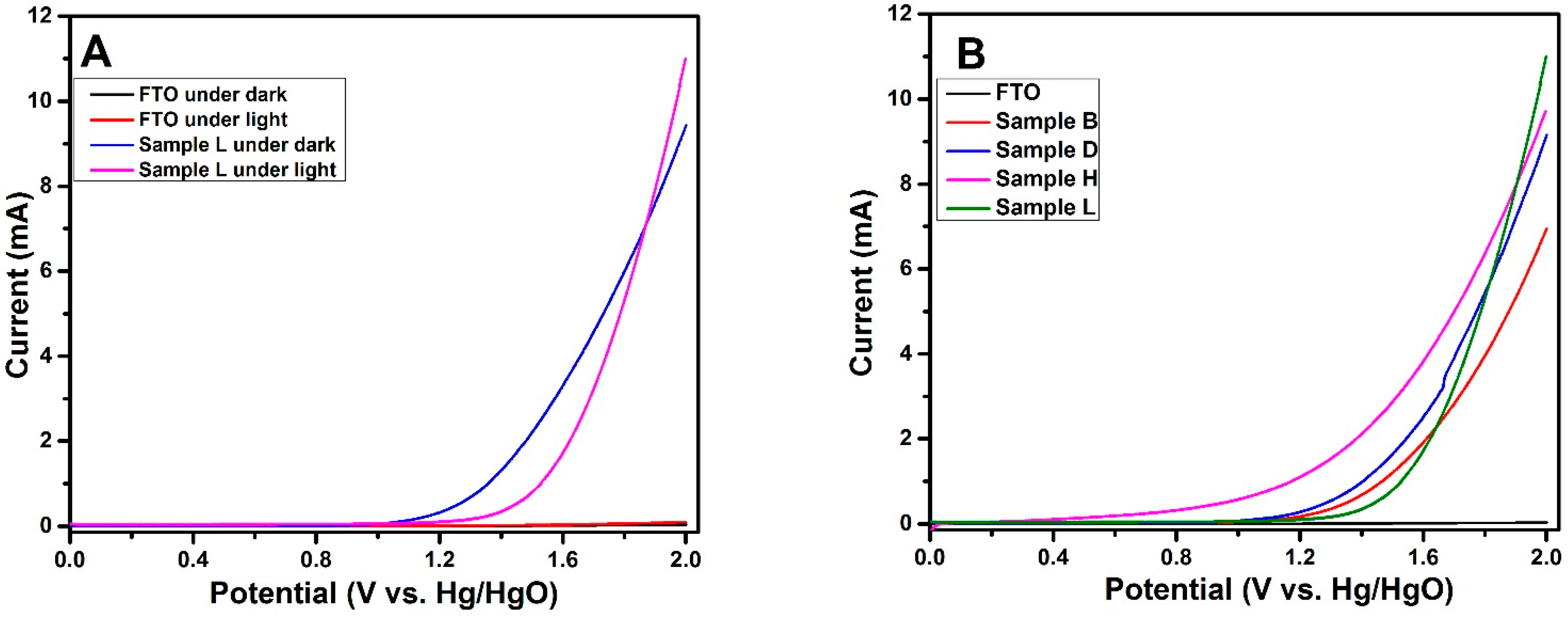
| No of Samples | Photoelectrode Architecture | Photoelectrode Labelling |
|---|---|---|
| 1 | Glass/FTO/TiO2:Mx | Sample A |
| 2 | Glass/FTO/TiO2:Mx/TiCl4 | Sample B |
| 3 | Glass/FTO/TiO2:Mx/TiCl4:0.25 Mx | Sample C |
| 4 | Glass/FTO/TiO2:Mx/TiCl4:0.37 Mx | Sample D |
| 5 | Glass/FTO/TiO2:Mx/mTiO2 | Sample E |
| 6 | Glass/FTO/TiO2:Mx/TiCl4:mTiO2 | Sample F |
| 7 | Glass/FTO/TiO2:Mx/TiCl4:0.25 Mx/mTiO2 | Sample G |
| 8 | Glass/FTO/TiO2:Mx/TiCl4:0.37 Mx/mTiO2 | Sample H |
| 9 | Glass/FTO/TiO2:Mx/mTiO2+Mx | Sample I |
| 10 | Glass/FTO/TiO2:Mx/TiCl4/mTiO2+Mx | Sample J |
| 11 | Glass/FTO/TiO2:Mx/TiCl4:0.25Mx/mTiO2+Mx | Sample K |
| 12 | Glass/FTO/TiO2:Mx/TiCl4:0.37Mx/mTiO2+Mx | Sample L |
Publisher’s Note: MDPI stays neutral with regard to jurisdictional claims in published maps and institutional affiliations. |
© 2021 by the authors. Licensee MDPI, Basel, Switzerland. This article is an open access article distributed under the terms and conditions of the Creative Commons Attribution (CC BY) license (https://creativecommons.org/licenses/by/4.0/).
Share and Cite
Iqbal, A.; Hamdan, N.M. Investigation and Optimization of Mxene Functionalized Mesoporous Titania Films as Efficient Photoelectrodes. Materials 2021, 14, 6292. https://doi.org/10.3390/ma14216292
Iqbal A, Hamdan NM. Investigation and Optimization of Mxene Functionalized Mesoporous Titania Films as Efficient Photoelectrodes. Materials. 2021; 14(21):6292. https://doi.org/10.3390/ma14216292
Chicago/Turabian StyleIqbal, Anum, and Nasser M. Hamdan. 2021. "Investigation and Optimization of Mxene Functionalized Mesoporous Titania Films as Efficient Photoelectrodes" Materials 14, no. 21: 6292. https://doi.org/10.3390/ma14216292
APA StyleIqbal, A., & Hamdan, N. M. (2021). Investigation and Optimization of Mxene Functionalized Mesoporous Titania Films as Efficient Photoelectrodes. Materials, 14(21), 6292. https://doi.org/10.3390/ma14216292






